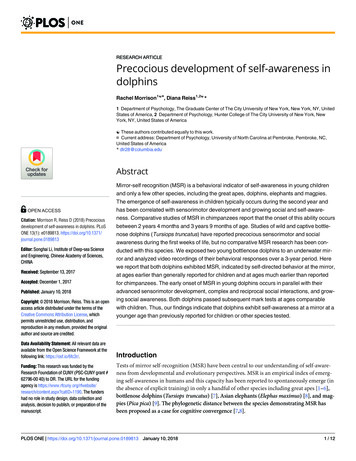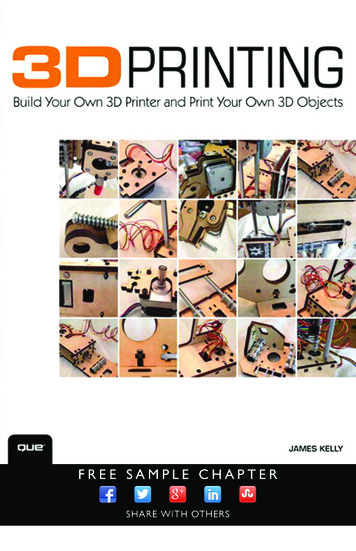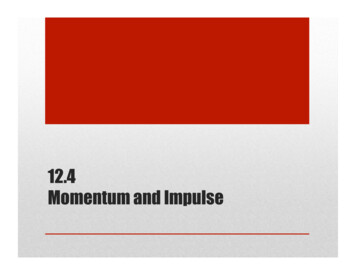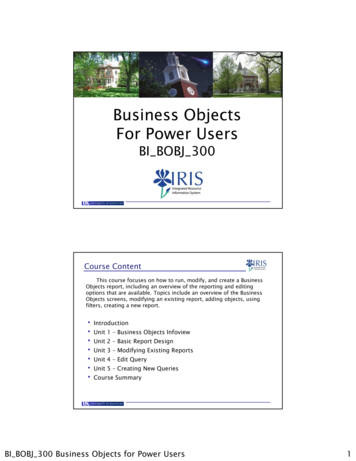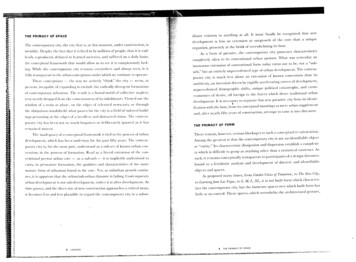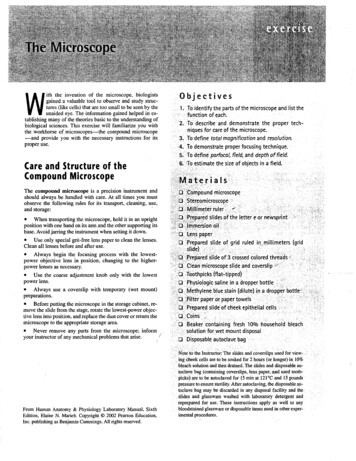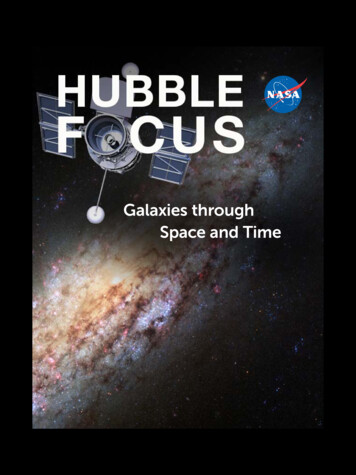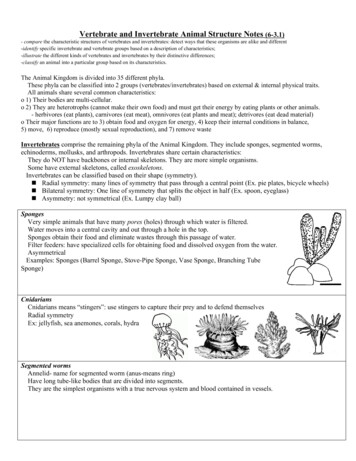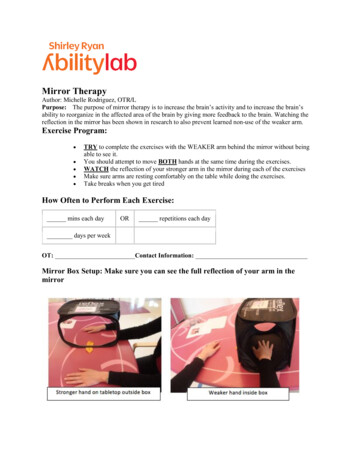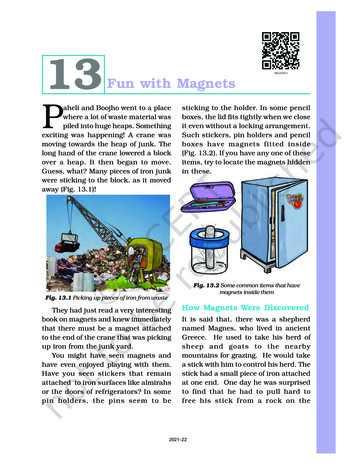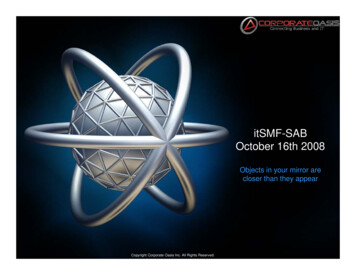
Transcription
itSMF-SABOctober 16th 2008Objects in your mirror arecloser than they appearCopyright Corporate Oasis Inc. All Rights Reserved.
AGENDA1Introductions2Today’s Topic The value of looking back through requirements tracing Gathering and Aligning to Requirements Mapping project activities and IT services to Requirements OASISOASIS ConnectedCd FrameworksFk3Audience Participation I have some ideas but don’t claim to have all the answers I want to engage the audience I want to share YOUR stories Mostly, I want someone to bail me out if I get stuck with a heckler4Q ACopyright Corporate Oasis Inc. All Rights Reserved.
Looking BackObjects In Mirror Are Closer Than They Appear
The Value of Looking BackA project is complete when you stop working for it and it starts working for youA poor example of looking backA great example of looking back(B(Bannisteri t anddLLandyd – 08/1954)(A ll 11 photo(Apolloh t off EarthE th anddMMoon – 07/1969)Questions:-If moving forward is so important then why does your car have one windshield and three mirrors?-Even your dashboard is a recorded history of things that have already happened-How would you feel if you drove your car without any mirrors or guages? Why?-You wouldn’t drive your car that way, why would you manage your IT Projects and Services that way?Looking back:pit ((Georgeg Santayana)y)-Those who do not learn from historyy are doomed to repeat-Luck is when preparation meets opportunity (Seneca – Roman dramatist, philosopher, politician)-Never have Children, they’ll break your heart (My Mother)Copyright Corporate Oasis Inc. All Rights Reserved.
Requirements TraceabilityMapping IT activities to Business DemandQuestion:Answer:What serves as IT’s rear view mirror? Service and Project metrics Requirements tracing-How are we doing?-Why are we doing it?What is traceability: Traceability is a means of mapping business needs to activities, deliverables and ongoing services Serves as a set of ‘bread crumbs’ to continually validate and verify project work Provides a means of measuring success Means of learning and applying change to processes for continual improvement Other measures exist, but they are more related to ‘How’ than ‘Why’The need for traceability: Aligning Requirements to Project Activities (Architecture, Development, Testing, etc) Aligning Project Activities to Project Deliverables AligningAli i PProjectj tDDeliverableslibl tot ChangesChini IT SServicesi Ultimately mapping new requirements to changes in services (through to Service Catalogue and CMDB) My favourite quote: “What are YOU doing today that will sell US more burgers?” (Dave Thomas of Wendy’s)Governance: BA: QA: SM: PM:Business Analysis is NOT just the responsibility of the businessQuality Management is NOT just the responsibility of the project testing teamService Management is NOT just responsibility of OperationsProject Manager must bring all of these fields together#1 Rule of Human BehaviourWhen we know WHY wewe’rere doing WHAT wewe’rere doingdoing, we’llwe ll do it BETTERCopyright Corporate Oasis Inc. All Rights Reserved.
IT Project Engagement Process-Business Making IT Successful-IT Does Not Engage Until Specific Criteria Are First Met-A model for MisalignmentCopyright Corporate Oasis Inc. All Rights Reserved.
IT Project Engagement Process-IT Making The Business Successful-IT and Business Engaging Collaboratively-A model for AlignmentCopyright Corporate Oasis Inc. All Rights Reserved.
Requirements Traceability DNA-TheThe Three PillarsBusinessAnalysisTranslatingBusiness Demand opyright Corporate Oasis Inc. All Rights Reserved.
Project TransitioningTransition 1: Engagement Why ITIL: AtAt thisthi stage,ttheth PProjectj t serves ththe SServicei MManagementt group The project helps to ensure that the SM group is engaged early and consistently Ensures that modified SM services are aligned to deliverables: Service Level Management Capacity, Availability, and Continuity Management ITIL V3 contains a phases specific to Service Management Design You’ve hired a BA/PM/SM and they appear to have all the answers at the start of the project (What do you do?) Engage BA/PM/SM resources and phases Early and Tightly Continually trace requirements Communicate changesg widelyy and frequentlyqy Enable feedback loop for changing / elaborating requirements (Change Control) Feedback future needs to the beginning of the cycle Plan to continually look back to ensure alignment from BA to PM to SM Capacity (current trends meeting plan?)Copyright Corporate Oasis Inc. All Rights Reserved.
Project TransitioningTransition 2: Deployment and Warranty Why ITIL: At this stage,g , Service Managementgserves the Projectj ITIL helps the project move smoothly into production ITIL V3 places a major emphasis on Service Transitioning as a formal phase of Service Management Ensures that the requirements move beyond the end of the project Manages changes to the CMDB, Media Libraries, Service Catalogue and SLAs The Project Is the Thing That happens in the middle (Apologies to PMs in the audience) Has ITIL Operational Transition occurred? Training gaps closed? Release Management engaged? Change Management processes in place and followed? Confirm traceability of Requirements through to new current state deliverables? Service Desk / incident management / problem management readiness and transitionCopyright Corporate Oasis Inc. All Rights Reserved.
Project TransitioningTransition 3: Disengagement Your Project is wrapping upup.NowNow what? Looking back for success ITIL V3 also places focus on CI (Continual Improvement) as a discipline of Service Management Don’t end the project until look-back is complete and gaps are closed through warranty Customer Satisfaction Survey executed? Deliverables Realization confirmed with client? Metrics pulled prior to Project Start? (Review Business Case / Charter) Are requirements traceable to the new operating environment? Deliverables Gaps Closed? Plan in place to close remaining gaps? Lessons Learned? Notification to other PM’s of lessons learned (Deming Cycle at the PMO level)? Documents and Templates updated to reflect lessons learned?Copyright Corporate Oasis Inc. All Rights Reserved.
Binding IT Activities, Deliverables and Services-BusinessBusiness Requirements are the common touch-pointtouch point-BA, PM, and SM become aligned through the requirements lifecycleBusiness RequirementsTechnical ntBusinessAnalysisBusiness Demand / OpportunityCurrent IT ServicesProjectjManagementModified IT ServicesServiceManagementProject DeliverablesCopyright Corporate Oasis Inc. All Rights Cycle Repeats
OCF – Oasis Connected Frameworks-BringingBringing It All TogetherPrimary IT Functional categories are: Business Analysis ProjectProject Management Service ManagementSupporting Guiding Principles: Financial Management through Total Cost of Ownership metrics Quality Management through ongoing Service Levels metrics (Project and Operational) Management of the Delivery of business functionality (Project and Operational) Encouraging and supporting good Governance Corporate Guiding Principles are incorporated into the Oasis Connected Frameworks (OCF)Supporting Disciplines and Frameworks: Service Management Process Quality Management Governance Enterprise Architecture Business Analysis Project ManagementITIL / ITSM / MOF (integrated with MSF 3.0)6SigmaSOX / COBIT / FOIPEABOK / ZACHMANN / TOGAF (The Open Group Architecture Framework)BABOKPMBOK / RUP / AGILEThe OCF is repeatable and scalable depending on the following influencers: Business drivers Business appetite for change Cultural Maturity Existing IT Methodologies Capability Maturity of both the business and competing influencers (CMM)All disciplines are based on the following SMART Objectives: Specific Measurable Achievable Realistic TimelyMetrics are defined and tracked through both Recursive Quality Management and Progressive Elaboration: PlanPl Do Check ActCopyright Corporate Oasis Inc. All Rights Reserved.
OCF – Oasis Connected Frameworks-AA New Model Emerges The model is intended to be: Open, Scalable and Light Weight (Remember SAA)? Adaptable to various SM, PM, and BA methodologies Technology and Vendor Independent Leverage best of breed based bodies of knowledge on the state of the industry (Frameworks and Methodologies) Integrate using Business Requirements as the common theme Will Focus on the following phases: Organizing Aligning Solutioning Implementing SupportingBusiness Analysis and GovernanceGovernance and consensus buildingProject Management, Service Management, and EAProject Management and Service ManagementService Management and Quality Management - Kaizen / DemingCopyright Corporate Oasis Inc. All Rights Reserved.
OCF – Oasis Connected Frameworks-KeyKey Points1. Always keep in mind the expectations of the business:1) Anticipate and Respond quickly to Business Opportunities / Demands2) KKeep expenses iin liline3) Continually maintain and improve service levels and align to Governance models4) There is no ‘4’2. Beware of the “IT Engagement Firewall”3. There is no direction that IT should move that is not ultimately driven by business requirements4 If that is not the case then you should test your assumptions4.Copyright Corporate Oasis Inc. All Rights Reserved.
OCF – Oasis Connected Frameworks-SummarySummary1. Trace business requirements to activities and trace activities to outcomes2. Engageg g and establish baselines with the business early,y, formallyy and tightlyg y3. Align to the vision and look back to learn / socialize lessons4. Ensure that BA, PM and SM activities become tightly integrated5. Encourage desired staff behaviour to align with business expectations6. Watch out for a gap between activities and requirements (this is an early warning for Misalignment)7. You have the keys, now enjoy the ride!Copyright Corporate Oasis Inc. All Rights Reserved.
QUESTIONSCopyright Corporate Oasis Inc. All Rights Reserved.
THANK YOUCopyright Corporate Oasis Inc. All Rights Reserved.
Enterprise Architecture EABOK / ZACHMANN / TOGAF (The Open Group Architecture Framework) Business Analysis BABOK Project ManagementProject Management PMBOK / RUP / AGILEPMBOK / RUP / AGILE The OCF is repeatable and scalable depending on the following influencers: Busine
